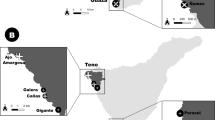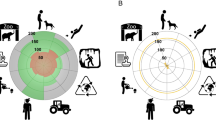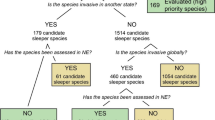Abstract
Landoltia punctata is an invasive aquatic plant that has spread across the United States. Unlike native duckweeds, this species has developed herbicide resistance. As a result, invasion can lead to high management costs and the loss of recreational areas and natural habitats. The species has been recently found in Europe, and is also approaching the northern US border with Canada. We predicted the potential distribution of L. punctata in western Europe and Canada using presence-only data from the Global Biodiversity Information Facility as well as other literature records. We fit predictive models to this data using a Maxent approach. Since climate data based on surface lake water conditions are often more relevant to macrophytes than air temperature metrics, our models included both water and air temperature bioclimatic variables related to the life history of the species. Model comparisons confirmed a superior fit of lake temperatures to duckweed distribution records. The best fit model suggests a high habitat suitability for the species in most Western European countries and Western Canada. A moderate emission scenario suggests that in 2041 currently compatible areas will still be suitable, and that the Great Lakes region will become suitable. Preventive measures to avoid future spread of L. punctata are recommended in these locations to avoid impacts associated with this and similar duckweed species in Europe and the US.



Similar content being viewed by others
Data availability
The data that support the findings of this study are openly available in Cuddington Lab repository at https://github.com/Cuddington-Lab/thermal-experiments/tree/main/distribution.
References
Ahmadi M, Hemami MR, Kaboli M, Shabani F (2023) MaxEnt brings comparable results when the input data are being completed; Model parameterization of four species distribution models. Ecol Evol 13(2):e9827
Al-Chokhachy R, Wenger SJ, Isaak DJ, Kershner JL (2013) Characterizing the thermal suitability of instream habitat for salmonids: a cautionary example from the Rocky Mountains. Trans Am Fish Soc 142(3):793–801
Allouche O, Tsoar A, Kadmon R (2006) Assessing the accuracy of species distribution models: prevalence, kappa and the true skill statistic (TSS). J Appl Ecol 43(6):1223–1232. https://doi.org/10.1111/j.1365-2664.2006.01214.x
Amaro G, Fidelis EG, da Silva RS, Marchioro CA (2023) Effect of study area extent on the potential distribution of species: a case study with models for Raoiella indica hirst (Acari: Tenuipalpidae). Ecol Model 483:110454
Armitage DW (2023) Global maps of lake surface water temperatures reveal pitfalls of air-for-water substitutions in ecological prediction. Ecography 2023(2):e06595
Armitage DW, Jones SE (2019) Negative frequency-dependent growth underlies the stable coexistence of two cosmopolitan aquatic plants. Ecology 100(5):e02657
Barbet-Massin M, Jiguet F, Albert CH, Thuiller W (2012) Selecting pseudo-absences for species distribution models: How, where and how many? Methods Ecol Evol 3(2):327–338
Branquart E, Brundu G, Buholzer S, Chapman D, Ehret P, Fried G, Tanner R (2016) A prioritization process for invasive alien plant species incorporating the requirements of EU Regulation no. 1143/2014. EPPO Bulletin 46(3):603–617
Center for Aquatic & Invasive Plants, University of Florida, IFAS (2023) Landoltia punctata – dotted duckweed. https://plants.ifas.ufl.edu/plant-directory/landoltia-punctata/
Ceschin S, Abati S, Ellwood N, Zuccarello V (2018) Riding invasion waves: spatial and temporal patterns of the invasive Lemna minuta from its arrival to its spread across Europe. Aquat Bot 150:1–8
Ceschin S, Ferrante G, Mariani F, Traversetti L, Ellwood NTW (2020) Habitat change and alteration of plant and invertebrate communities in waterbodies dominated by the invasive alien macrophyte Lemna minuta Kunth. Biol Invasions 22:1325–1337
Cobos ME, Peterson AT (2023) Broad-scale factors sha** the ecological niche and geographic distribution of Spirodela polyrhiza. PLoS ONE 18(5):e0276951
Copernicus Programme, European Commission (2023) European summer 2023: a season of contrasting extremes. https://climate.copernicus.eu/european-summer-2023-season-contrasting-extremes
Cuthbert RN, Pattison Z, Taylor NG, Verbrugge L, Diagne C, Ahmed DA, Courchamp F (2021) Global economic costs of aquatic invasive alien species. Sci Total Environ 775:145238
Duenas MA (2022) Lemna minuta. CABI, CABI Compendium. https://doi.org/10.1079/cabicompendium.108968
Elith J, Graham CH, Anderson RP, Dudík M, Ferrier S, Guisan A, Zimmermann NE (2006) Novel methods improve prediction of species’ distributions from occurrence data. Ecography 29(2):129–151
Elith J, Kearney M, Phillips S (2010) The art of modelling range-shifting species. Methods Ecol Evol 1:330–342
Elith J, Phillips SJ, Hastie T, Dudík M, Chee YE, Yates CJ (2011) A statistical explanation of MaxEnt for ecologists. Divers Distrib 17(1):43–57
Environment Canada (2023) Temperature climatology - map - average - Jun-Jul-Aug (summer). https://weather.gc.ca/saisons/image_e.html?format=clim_stn&season=jja&type=temp
European and Mediterranean Plant Protection Organization (EPPO) (2015) Global Database. Landoltia punctata: a new documented species. https://gd.eppo.int/reporting/article-4787
European Union (2023) Euro+Med PlantBase Landoltia punctata. https://www.europlusmed.org/cdm_dataportal/taxon/a3b4b6a7-8144-42d9-92d9-c677c1352f82#distribution
Eurostat, European Union (2021) Aquaculture statistics. https://ec.europa.eu/eurostat/databrowser/view/fish_aq2a/default/table?lang=en
Fick SE, Hijmans RJ (2017) WorldClim 2: new 1km spatial resolution climate surfaces for global land areas. Int J Climatol 37(12):4302–4315
Finnish Biodiversity Information Facility (2023) Landoltia punctata species information card. https://laji.fi/en/taxon/MX.41521
Fisheries and Oceans Canada (2016) Aquaculture Collaborative Research and Development Program (ACRDP) Fact Sheet. Aquaculture Science Branch. https://www.dfo-mpo.gc.ca/aquaculture/acrdp-pcrda/fsheet-ftechnique/issue-fiche-06-eng.html
GBIF.org (2023) GBIF Occurrence Download https://doi.org/10.15468/dl.g5m5h8
GBIF.org (2024) GBIF Occurrence Download https://doi.org/10.15468/dl.7uqs9k
Gérard J, Triest L (2014) The effect of phosphorus reduction and competition on invasive lemnids: Life traits and nutrient uptake. International Scholarly Research Notices 2014:514294
Hijmans RJ, Phillips S, Leathwick J, Elith J (2011) Package ‘dismo’. http://cran.r-project.org/web/packages/dismo/index.html.
Jacono CC, Pfingsten IA (2023) Landoltia punctata (G. Mey.) Les & D.J. Crawford: U.S. geological survey, nonindigenous aquatic species database, Gainesville, FL, https://nas.er.usgs.gov/queries/FactSheet.aspx?speciesID=1116, Revision Date: 8/30/2023, Access Date: 10/13/2023
Jacono C (2002) Landoltia punctata (G. Mey.) Les & D.J. Crawford. U.S. Department of the Interior & U.S. Geological Survey. https://nas.er.usgs.gov/taxgroup/plants/fact%20sheets/Landoltia%20punctata.pdf.
Jewell MD, Bell G (2023) Overwintering and re-emergence in Lemna minor. Aquat Bot 186:103633
Jewitt A (2021) ArcGIS StoryMap: invasive species factsheet: dotted duckweed. Pennsylvania natural heritage program and Western Pennsylvania conservancy. https://storymaps.arcgis.com/stories/14f81675ae834f8aa1c18ef71463554b
Koschnick TJ, Haller WT, Glasgow L (2006) Documentation of landoltia (Landoltia punctata) resistance to diquat. Weed Sci 54(4):615–619
Landolt E (1986) The family of Lemnaceae—a monographic study. Ver Geobot Inst ETH Stift Rübel 71:1–563
Landolt E, Kandeler R (1987) The family of Lemnaceae — a monographic study. Vol. 2: Phytochemistry, physiology, application, bibliography. Ver Geobot Inst ETH Stift Rübel 95:1–638
Li S, Wang Z, Zhu Z, Tao Y, **ang J (2023) Predicting the potential suitable distribution area of Emeia pseudosauteri in Zhejiang Province based on the MaxEnt model. Sci Rep 13(1):1806
Lockwood JL, Cassey P, Blackburn T (2009) The more you introduce the more you get: the role of colonization pressure and propagule pressure in invasion ecology. Divers Distrib 15:904–910
Mainali KP, Warren DL, Dhileepan K, McConnachie A, Strathie L, Hassan G, Parmesan C (2015) Projecting future expansion of invasive species: comparing and improving methodologies for species distribution modeling. Glob Change Biol 21(12):4464–4480
Merow C, Smith MJ, Silander JA Jr (2013) A practical guide to MaxEnt for modeling species’ distributions: what it does, and why inputs and settings matter. Ecography 36(10):1058–1069
Muscarella R, Galante PJ, Soley-Guardia M, Boria RA, Kass JM, Uriarte M, Anderson RP (2014) ENM eval: an R package for conducting spatially independent evaluations and estimating optimal model complexity for maxent ecological niche models. Methods Ecol Evol 5(11):1198–1205. https://doi.org/10.1111/2041-210X.12261
Njambuya J, Stiers I, Triest L (2011) Competition between Lemna minuta and Lemna minor at different nutrient concentrations. Aquat Bot 94(4):158–164
NOBANIS (2011) (European Network on Invasive Alien Species) Landoltia punctata in Sweden. https://www.nobanis.org/national-species-info/?taxaid=13827&countryID=SE
O’Donnel MS, Ignizio DA (2012) Bioclimatic predictors for supporting ecological applications in the conterminous United States (No. 691). US Geological Survey.
Ontario Newsroom (2023) Ontario designates new invasive species. https://news.ontario.ca/en/backgrounder/1003960/ontario-designates-new-invasive-species
Paolacci S, Harrison S, Jansen MA (2016) A comparative study of the nutrient responses of the invasive duckweed Lemna minuta, and the native, co-generic species Lemna minor. Aquat Bot 134:47–53
Paolacci S, Harrison S, Jansen MA (2018a) Are alien species necessarily stress sensitive? A case study on Lemna minuta and Lemna minor. Flora 249:31–39
Paolacci S, Jansen MA, Harrison S (2018b) Competition between Lemna minuta, Lemna minor, and Azolla filiculoides. growing fast or being steadfast? Front Chem 6:207
Paolacci S, Jansen MA, Stejskal V, Kelly TC, Coughlan NE (2023) Metabolically active angiosperms survive passage through the digestive tract of a large-bodied waterbird. Royal Society Open Science 10(3):230090
Phillips SJ, Anderson RP, Dudík M, Schapire RE, Blair ME (2017) Opening the black box: an open-source release of Maxent. Ecography 40(7):887–893
Pimentel D, Lach L, Zuniga R, Morrison D (2000) Environmental and economic costs of nonindigenous species in the United States. Bioscience 50(1):53–65
R Core Team (2021) R: A language and environment for statistical computing. R Foundation for Statistical Computing, Vienna, Austria. URL https://www.R-project.org/.
Roberts DR, Bahn V, Ciuti S, Boyce MS, Elith J, Guillera-Arroita G, Dormann CF (2017) Cross-validation strategies for data with temporal, spatial, hierarchical, or phylogenetic structure. Ecography 40(8):913–929
Ruete A, Leynaud GC (2015) Goal-oriented evaluation of species distribution models’ accuracy and precision: true skill statistic profile and uncertainty maps. PeerJ PrePrints 3:12081
Smith RE, Velhuis H, Mills G, Eilers R, Fraser W, Lelyk G (1998) Terrestrial ecozones, ecoregions, and ecodistricts of Manitoba. Technical bulletin, 9.
Tippery NP, Les DH (2020) Tiny plants with enormous potential: phylogeny and evolution of duckweeds. The duckweed genomes, 19–38.
US Army Corps of Engineers (2013) The Great Lakes & Mississippi River Interbasin Study. Focus area 2: aquatic pathway assessment report. https://glmris.anl.gov/glmris-report/
Van Echelpoel W, Boets P, Goethals PL (2016) Functional response (FR) and relative growth rate (RGR) do not show the known invasiveness of Lemna minuta (Kunth). PLoS ONE 11(11):e0166132
van Valkenburg JLCH, Pot R (2008) Landoltia punctata (G.Mey.) D.H.Les & D.J.Crawford (Smal kroos), nieuw voor Nederland. Gorteria 33:41–49
van Valkenburg JLCH, Pot R (2008) Landoltia punctata (G. Mey.) DH Les & DJ Crawford (Smal kroos), nieuw voor Nederland. Gorteria Dutch Botanical Archives 33(2):41–49
Wang T, Hamann A, Spittlehouse D, Carroll C (2016) Locally downscaled and spatially customizable climate data for historical and future periods for North America. PLoS ONE 11(6):e0156720. https://doi.org/10.1371/journal.pone.0156720
Warren J, Neil J, Assessment and control of duckweed in the Maskinonge River, Keswick, Ontario. Technical Report: Imp. B.6. Lake Simcoe Environmental Management Strategy. https://atrium.lib.uoguelph.ca/server/api/core/bitstreams/76f9462a-229a-480d-a114-82834e8f2637/content
Wersal RM, Madsen JD (2009) Combinations of diquat and a methylated seed oil surfactant for control of common duckweed and watermeal. J Aquat Plant Manage 47:59–62
Wisconsin Department of Natural Resources (2018) Landoltia punctata. https://dnr.wi.gov/topic/Invasives/documents/classification/Landoltia%20punctata.pdf
Ziegler P, Adelmann K, Zimmer S, Schmidt C, Appenroth KJ (2015) Relative in vitro growth rates of duckweeds (Lemnaceae)–the most rapidly growing higher plants. Plant Biol 17:33–41
Ziegler P, Appenroth KJ, Sree KS (2023) Survival strategies of duckweeds, the world’s smallest angiosperms. Plants 12(11):2215
Funding
This research was supported by NSERC (Natural Sciences and Engineering Research Council of Canada) Discovery Grant to KC.
Author information
Authors and Affiliations
Contributions
D.A.P and K.C. wrote the main manuscript text and D.A.P prepared models and figures. All authors reviewed model analyses and the manuscript.
Corresponding author
Ethics declarations
Competing interests
The authors declare no competing interests.
Additional information
Communicated by Hsiao-Hsuan Wang.
Publisher's Note
Springer Nature remains neutral with regard to jurisdictional claims in published maps and institutional affiliations.
Supplementary Information
Below is the link to the electronic supplementary material.
Rights and permissions
Springer Nature or its licensor (e.g. a society or other partner) holds exclusive rights to this article under a publishing agreement with the author(s) or other rightsholder(s); author self-archiving of the accepted manuscript version of this article is solely governed by the terms of such publishing agreement and applicable law.
About this article
Cite this article
Andrade-Pereira, D., Cuddington, K. Range expansion risk for a newly established invasive duckweed species in Europe and Canada. Plant Ecol (2024). https://doi.org/10.1007/s11258-024-01436-3
Received:
Accepted:
Published:
DOI: https://doi.org/10.1007/s11258-024-01436-3




